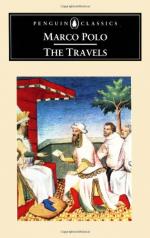Ibn Batuta describes the Tartar waggon in which he travelled to Sarai as mounted on four great wheels, and drawn by two or more horses:—
“On the waggon is put a sort of pavilion of wands laced together with narrow thongs. It is very light, and is covered with felt or cloth, and has latticed windows, so that the person inside can look out without being seen. He can change his position at pleasure, sleeping or eating, reading or writing, during the journey.” These waggons were sometimes of enormous size. Rubruquis declares that he measured between the wheel-tracks of one and found the interval to be 20 feet. The axle was like a ship’s mast, and twenty-two oxen were yoked to the waggon, eleven abreast. (See opposite cut.) He describes the huts as not usually taken to pieces, but carried all standing. The waggon just mentioned carried a hut of 30 feet diameter, for it projected beyond the wheels at least 5 feet on either side. In fact, Carpini says explicitly, “Some of the huts are speedily taken to pieces and put up again; such are packed on the beasts. Others cannot be taken to pieces, but are carried bodily on the waggons. To carry the smaller tents on a waggon one ox may serve; for the larger ones three oxen or four, or even more, according to the size.” The carts that were used to transport the Tartar valuables were covered with felt soaked in tallow or ewe’s milk, to make them waterproof. The tilts of these were rectangular, in the form of a large trunk. The carts used in Kashgar, as described by Mr. Shaw, seem to resemble these latter. (I. B. II. 381-382; Rub. 221; Carp. 6, 16.)
The words of Herodotus, speaking generally of the Scyths, apply perfectly to the Mongol hordes under Chinghiz: “Having neither cities nor forts, and carrying their dwellings with them wherever they go; accustomed, moreover, one and all, to shoot from horseback; and living not by husbandry but on their cattle, their waggons the only houses that they possess, how can they fail of being unconquerable?” (Bk. IV. ch. 46, p. 41, Rawlins.) Scythian prisoners in their waggons are represented on the Column of Theodosius at Constantinople; but it is difficult to believe that these waggons, at least as figured in Banduri, have any really Scythian character.
It is a curious fact that the practice of carrying these yurts or felt tents upon waggons appears to be entirely obsolete in Mongolia. Mr. Ney Elias writes: “I frequently showed your picture [that opposite] to Mongols, Chinese, and Russian border-traders, but none had ever seen anything of the kind. The only cart I have ever seen used by Mongols is a little low, light, roughly-made bullock-dray, certainly of Chinese importation.” The old system would, however, appear to have been kept up to our own times by the Nogai Tartars, near the Sea of Azof. (See note from Heber, in Clark’s Travels, 8vo ed. I. 440, and Dr. Clark’s vignette at p. 394 in the same volume.)




